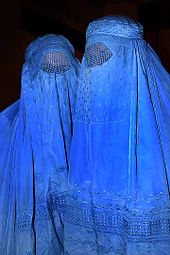The law relates to the time where the secular French state took over control of most schools from the Catholic Church. It does not apply to private or religious schools. This was followed on 22 June 2009, when the president of France, Nicolas Sarkozy, said that burqas are "not welcome" in France, commenting that "In our country, we cannot accept that women be prisoners behind a screen, cut off from all social life, deprived of all identity".[18]
(espero sea toda Europa)
pero por lo visto la prohibición es sólo en lo público... por lo tanto las mujeres seguirán enjaulando sus cabezas, en casa, siguiendo sus convicciones.
Nigab (según la "cultura islámica")
Burqa (según la "cultura islámica")
Enveloping outer garments, such as the burqa, are believed to cause or worsen medical conditions in some individuals.[31] In particular, they contribute to a predisposition for hypovitaminosis D, which can lead to rickets or osteoporosis and may increase the risk of seizures in infants born to affected mothers.
The full Afghan chadri covers the wearer's entire face except for a small region about the eyes, which is covered by a concealing net or grille.[5]
Before the Taliban took power in Afghanistan, the chadri was infrequently worn in cities. While they were in power, the Taliban treatment of women required the wearing of a chadri in public. Officially, it is not required under the present Afghan regime, but local warlords still enforce it in southern Afghanistan. Chadri use in the remainder of Afghanistan is variable and is observed to be gradually declining in Kabul. Due to political instability in these areas, women who might not otherwise be inclined to wear the chadri must do so as a matter of personal safety.



No hay comentarios.:
Publicar un comentario